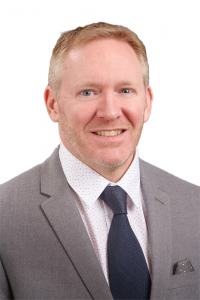Cardiologist talks about ‘exciting field” of cardiology and ‘significant advances’ in patient care in WNY
By Chris Motola

Q: What can you tell us about practicing cardiology in Western New York? Are there regional issues?
A: Cardiology is a very exciting field. There’s been a tremendous amount of innovation, even just since I came out of training in 2003. How we do things is a lot different. There have been significant advances in care in terms of medical therapies, device therapies, minimally invasive surgeries, catheter-based interventions to replace heart valves and things like that. So, the good thing about being in Western New York is that the quality of care is great. I’m affiliated with the Kaleida system, and the Gates Vascular Institute has some incredible innovators and thought-leaders who are really providing cutting edge care. In the past, people had to leave Buffalo for more complex conditions and go to Cleveland or Rochester. Now we can handle most conditions with some rare exceptions.
Q: How bad is the incidence of heart problems in the region?
A: Western New York has a high rate of heart disease. New York state overall has the 17th highest rate of deaths heart disease of the 50 states, and within New York state, Western New York is a big part of that. So, we have a lot of challenges here in terms of risk factors. It’s my job as a cardiologist to treat heart disease, but I have a special interest in prevention and getting there before the first heart attack.
Q: What are some of the risk factors that are common in Western New York?
A: A big one is cigarette smoking. The statistics are improving, but still around 16% of adults are still smoking. Obesity rates are alarming —37, 38% of adults nationwide are technically obese. That number might be slightly higher in New York state. The youth obesity rate is 18, 19%. As far as high cholesterol, about a third of U.S. adults have elevated LDL cholesterol. Forty-five percent have hypertension. Diabetes is about 9 or 10%, with another 3 to 4% who aren’t diagnosed. Around 30% of adults aren’t engaged in any kind of substantial physical activity. So what goes into heart disease is all of those. The numbers are pretty alarming. So on the one hand, we’ve made huge medical advances: the death rate from cardiovascular disease has decreased by 31.8%, which is amazing. However, the risk factors are all still there, and they’re getting worse. People are surviving their heart disease and getting older than they would have been able to in the past, but they’re also getting sicker.
It’s my job as a cardiologist to treat heart disease, but I have a special interest in prevention and getting there before the first heart attack.
Q: Since most of these are behavioral issues, how do you, as a doctor, try to modify people’s behavior?
A: That is the challenge. It really should start at a younger age. Prevention starts as early as possible. The recommendation would be to get established with a primary care provider you trust so you know what your blood pressure is, what your cholesterol is. The focus should be on getting some of these healthy lifestyles adapted earlier rather than later. The American diet? There’s a lot wrong there. The processed foods, abundance of starches, high fat content. It’s often expensive to eat healthy. So how do you change that? Efforts at prevention have always been challenging, but once you get them, you can work with them in terms of attacking all of these things. So, I’d like to see more support from the local insurance companies as far as supporting prevention efforts and work with dietitians. It’s easy for me as a doctor to tell people to eat better, but a lot of people need help with that.
Q: I believe you recently traveled to Greece. Do they follow a better diet?
A: I just got back from Greece and it was really eye opening. My wife has family there. They have smaller refrigerators, they buy their food usually for the day rather than the week. It might be different in the bigger cities, but there isn’t much fast food. Everything is fresh, freshly made. People walk more. It’s just a healthier lifestyle in general. So that was interesting to see how they do things a little differently.
Q: I understand you’re pretty active yourself. You participate in the Tough Mudder endurance competition. So in training for that, do you feel like it puts you in a position to dispense more useful advice in terms of giving exercise advice?
A: Yeah, exactly. You just kind of practice what you preach. I think the official recommendations of the American Heart Association is 150 minutes of moderate intensity activity a week, or 75 minutes of more vigorous activity. I fall short of that too. We do the best we can. I try to tell patients some of the stuff I do and sometimes it inspires them.
Q: What are some warning signs of heart disease?
A: There are symptoms that are brought on with physical exertion. So if someone’s experiencing tightness or pressure in their chest, jaw or arm, and it’s brought on with physical activity or emotional stress and it’s relieved with rest, that will always get our attention. There’s increased awareness now of women with heart disease, and they can often present in different ways. They may not have the chest pain. It may just be shortness of breath, which unfortunately can be attributed to any number of things. It might be shoulder blade pain. In general, though, [if there are] exertional symptoms, especially ones that are lasting longer, there may be an issue.
Q: What should people be keeping an eye on?
A: It comes back to having a good primary care provider. They should know what their blood pressure is, what their cholesterol levels are. Get your blood sugar checked once a year to make sure you’re not diabetic.
Q: What’s it like working with the Great Lakes Cardiovascular group?
A: It’s exciting. It’s a multispecialty group, so there are a growing number of primary care providers and specialists. It’s nice having all of the patients’ information in one place and not having to go search with multiple different electronic records, which avoids a lot of delays and errors. It’s nice having that all under one umbrella. Currently I’m on a committee to help design the newest EMR. It’ll be a combined inpatient and outpatient EMR, so we’ll know exactly what’s going on, if medications were changed during an inpatient stay.
Lifelines
Name: Brian J. Riegel, M.D.
Position: Great Lakes Cardiovascular, a General Physician, PC practice. He sees patients in Williamsville and Orchard Park
Hometown: Amherst
Education: University at Buffalo, medical degree; internal medicine internship (chief residency) at St. Elizabeth’s Medical Center of Boston, affiliated with Tufts University; cardiology fellowship at University at Buffalo; Canisius College (undergraduate degree)
Affiliations: Millard Fillmore Suburban Hospital
Organizations: American College of Cardiology; Medical Society of the State of New York; American Medical Association; American Society of Nuclear Cardiology; American Society of Echocardiography
Family: Wife, Nina, and two daughters: Demi, 16, and Ava, 12
Hobbies: Exercise, travel

